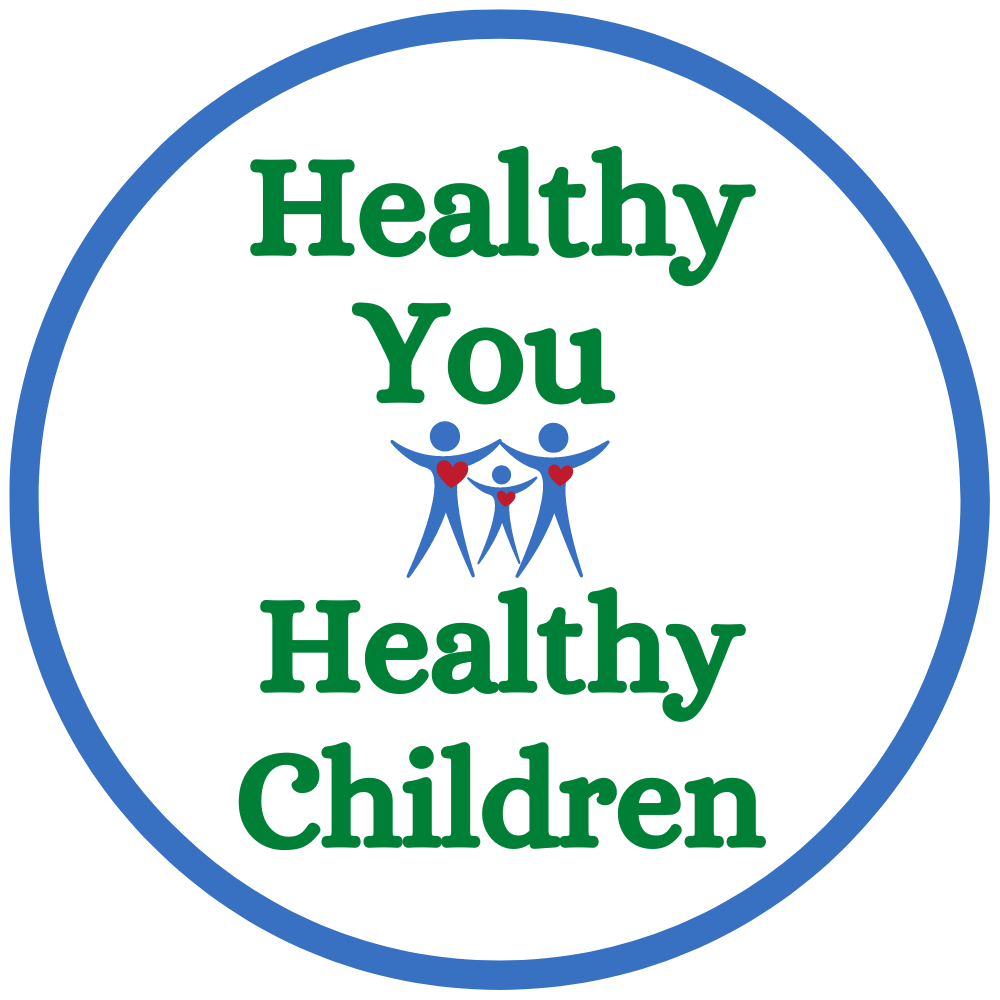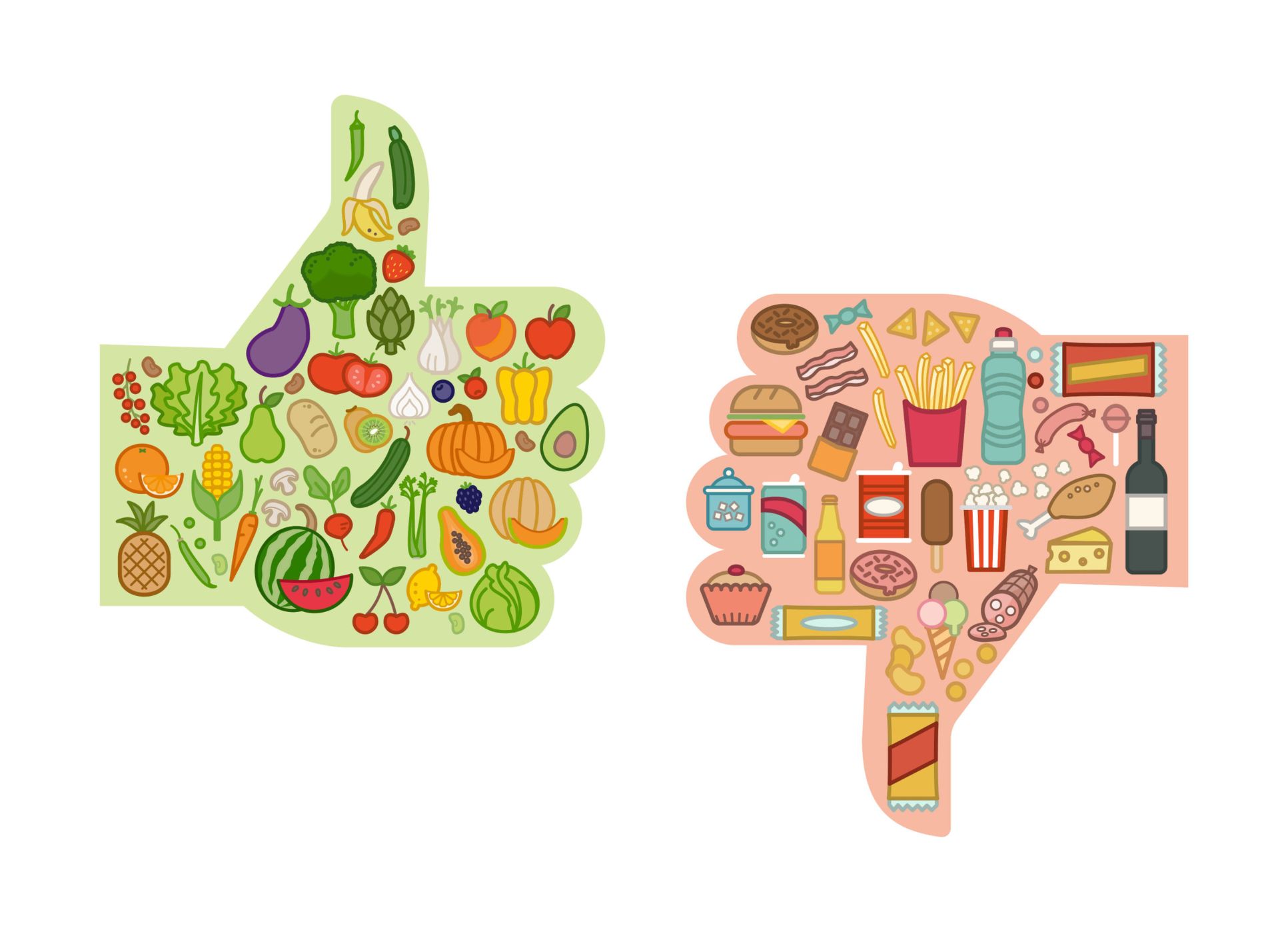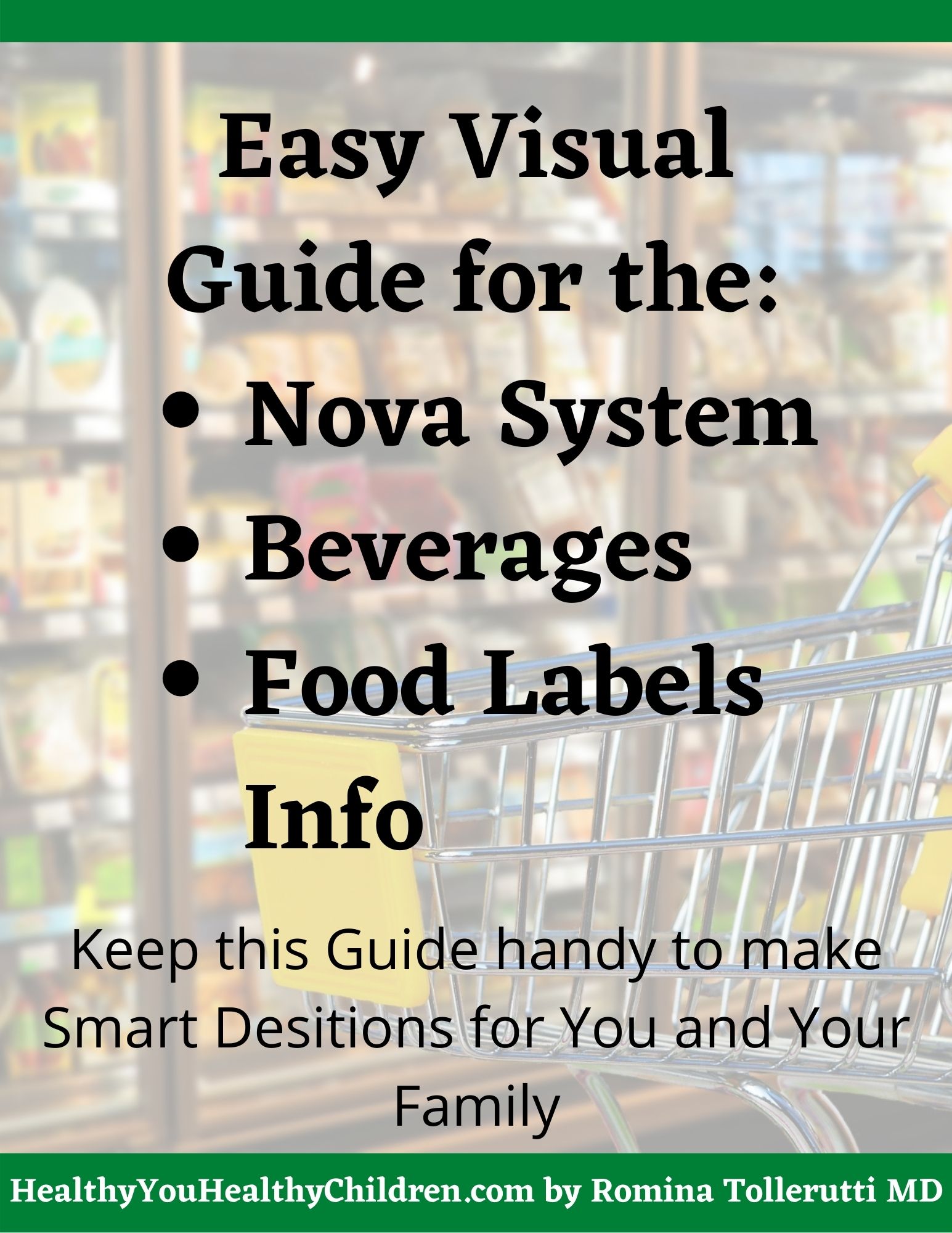You must probably have heard, including from me, how important it is to clean your diet from Ultra-Processed Foods (generally called just Processed by most people) and choose whole foods for your overall health. But, what exactly is Ultra-Processed Food? One of the most used classifications is the NOVA System. Keep reading to learn about it to better understand the importance of choosing what you eat, plus some science behind this recommendation.
What is The NOVA System classification?
The NOVA System Classification was developed by scientists at the University of Sao Paulo in Brazil. It helps people group foods according to the extent and purpose of the processing they undergo. NOVA identifies food processing as physical, biological, and chemical steps that occur after foods are taken from nature and consumed or used to prepare dishes and meals.
What are the Food Groups according to NOVA?
#1 Unprocessed Foods
This group includes fruits, vegetables, meat, eggs, milk, seeds, fungi, or grains. These foods did not go under industrial processing or alteration. Therefore, no new substances such as fats, sugar, or salt were added.
#2 Minimally Processed Foods
This group includes the ones in #1. Still, they underwent a minimal process for preservation, making them ready for storage or making them safe and edible. The minimal processing involves pasteurization, refrigeration, freezing, removing unwanted parts, drying, grinding, roasting, boiling, packed in a container, to mention some. Examples are pasteurized milk, frozen veggies or fruits, frozen meat, pre-cut produce.
#3 Processed Culinary Ingredients
This group includes oil, sugar, honey, butter, and salt. They are extracted from unprocessed foods or obtained from nature (pressing, grinding, refining, milling, drying). We use them to make dishes and meals with unprocessed or minimally processed foods (group #1 and #2).
#4 Processed foods
This group includes foods that add salt, oil, sugar, or other culinary ingredients to minimally processed foods. The purpose is to increase the durability of foods in groups #1 and #2 or to enhance or modify their taste or texture. Examples are cheese, cured or smoked meats, canned fruits or vegetables, freshly made bread, and salted nuts.
#4 Ultra-processed foods
This group is the one to avoid. These foods are the highest end of the processing spectrum defined as multi-ingredient industrial formulations. Why are these made? To have branded, convenient (ready-to-consume), highly palatable, and highly profitable products (attractive). They contain few unprocessed or minimally processed foods. Their main ingredients are industrial: additives, preservatives, antioxidants, stabilizers, colorants, artificial flavors, carbonations, and anticaking agents.
Examples are sugar-sweetened beverages (SSBs), packaged bread, cookies, sweet or savory packaged snacks, candy, ice cream, breakfast cereal, reconstituted meat products, and pre-prepared frozen meals.
“Ultra-processed products are made from processed substances extracted or refined from whole foods…Most are made, advertised, and sold by large or transnational corporations and are very durable, palatable, and ready to consume, which is an enormous commercial advantage over fresh and perishable whole or minimally processed foods . . . [They] are typically energy-dense; have a high glycemic load; are low in dietary fiber, micronutrients, and phytochemicals; and are high in unhealthy types of dietary fat, free sugars, and sodium.“
Moodie R, Stuckler D, Monteiro C et al. Profits and pandemics: prevention of harmful effects of tobacco, alcohol, and ultra-processed food and drink industries. Lancet 2013; 381: 670–679.14. Moodie R, Stuckler D, Monteiro C et al. Profits and pandemics: prevention of harmful effects of tobacco, alcohol, and ultra-processed food and drink industries. Lancet 2013; 381: 670–679.
Following the NOVA System Classification, I will refer to the popular Processed Food name as Ultra-Processed Food.
Scientific Facts About Ultra-Processed Foods?
This group of foods is highly addictive and makes you crave them frequently. Some researchers suggest that ultra-processed foods’ high refined carbohydrate or fat content may produce changes in the reward brain circuit, leading to addictive-like eating behaviors and overconsumption. My article about Added Sugars mentions this critical topic (read HERE).
Similarly, Researchers at the National Institutes of Health published a study in May 2019, showing that eating a diet of ultra-processed foods drives people to overeat and gain weight compared with a diet made up of whole or minimally processed foods. Study participants on the ultra-processed diet ate an average of 508 calories more per day. They ended up gaining an average of 2 pounds over two weeks. Meanwhile, people on the unprocessed diet ended up losing about 2 pounds on average over two weeks. Concluding that limiting the consumption of ultra-processed food may be an effective strategy for obesity prevention and treatment.
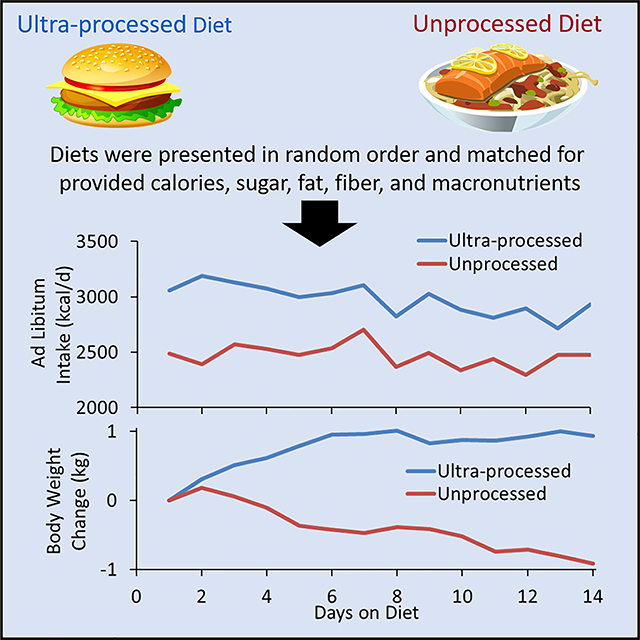
Ultra-Processed Diets Cause Excess Calorie Intake and Weight Gain: An Inpatient Randomized Controlled Trial of Ad Libitum Food Intake. Kevin D. Hall, Alexis Ayuketah, Robert Brychta, Peter J. Walter, Shanna Yang, Megan Zhou. Published: May 16, 2019 DOI: https:// doi.org/10.1016/j.cmet.2019.05.008
What about children?
The following study: “Trends in Consumption of Ultraprocessed Foods Among US Youths Aged 2-19 Years, 1999-2018”, published in JAMA, showed very concerning results.
Given the steadily rising rate of childhood obesity among US youths during the past 2 decades, this study analyzed the dietary intake in children from 1999 to 2018. Their conclusion: “Based on the NHANES cycles from 1999 to 2018, the estimated proportion of energy intake from consumption of ultra-processed foods has increased among youths in the US. It has consistently comprised the majority of their total energy intake.”
“In 2017-2018, the subgroups of ultra-processed foods that contributed to the largest estimated percentage of energy were industrial grain foods (14.5%, cereal and nutrition bars), followed by sweet snacks and sweets (12.9%, sweet bakery products) and ready-to-heat and -eat mixed dishes (11.1%, pizza, sandwiches, hamburgers, and others).”
Even though consumption of sweetened beverages has declined during this period, bakery products like cakes, pies, cookies, brownies, doughnuts, and sweet snacks (such as candy and ice cream) are the second most commonly consumed source of added sugars among US youths, according to this study (accounting for approximately 21%-31% of total added sugars consumed by US youths).
JAMA | OriginalInvestigation Trends in Consumption of Ultraprocessed Foods Among US Youths Aged 2-19 Years, 1999-2018 Lu Wang, PhD, MPH; Euridice Martínez Steele, PhD; Mengxi Du, MS, MPH, RD;Jennifer L. Pomeranz, JD, MPH, RD; Lauren E. O’Connor, Ph.D., MPH; Kirsten A. Herrick, Ph.D., MSc; Hanqi Luo, Ph.D.; Xuehong Zhang, Ph.D.; Dariush Mozaffarian, MD, DrPH; Fang Fang Zhang, MD, PhD
Why Is It Important to You and Your Family?
Ultra-processed foods have been associated with an increased rate of obesity and related chronic health problems like diabetes and cardiovascular disease worldwide. As mentioned before, it is highly palatable, durable, ready to take, and often cheaper than unprocessed or minimally processed food.
Food processing removes fiber, phytochemicals, vitamins, minerals, beneficial fatty acids, and other components important in our nutrition. Additionally, ultra-processed foods tend to be high in added sugars and refined starches. Refined grains and starches in processed foods are rapidly digested into glucose and absorbed into the bloodstream more quickly and significantly than natural sugars from unprocessed food. This increases the risk of weight gain, diabetes, and other adverse health effects of an unhealthy metabolism.
Many of the preservatives and additives found in Ultra-Processed Foods have been linked to health problems:
- High Fructose Corn Syrup is found in many products, increasing the risk for many health problems. Read my article about Added Sugar for more information (HERE).
- Depression, irritability, and inability to concentrate have been linked to Ultra-processed food.
- Sulfites have been associated with headaches, irritable bowel syndrome, diarrhea, and allergic reactions like skin rashes, asthma, and life-threatening anaphylaxis in sensitive individuals.
- Frequent consumption of Ultra-processed foods can lead to hormonal problems like menstrual irregularities, premenstrual syndrome, infertility, and thyroid dysfunction.
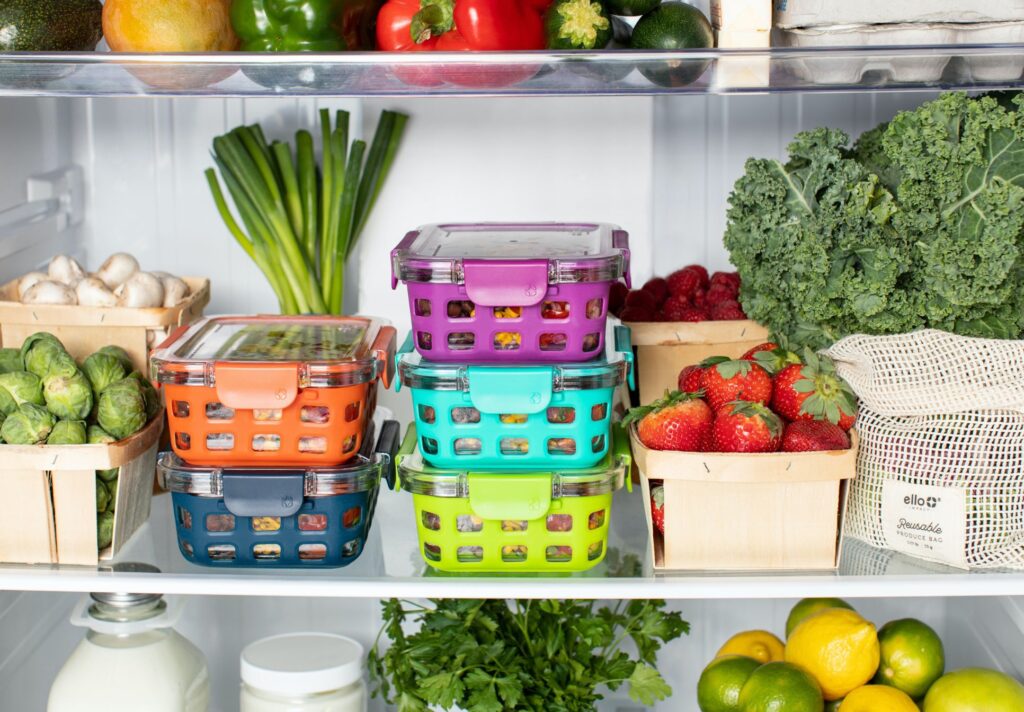
Best Home Tips:
- Reading labels is essential to buy the best food options for you and your family. If not sure how to do it, read my article about Food Label (read HERE).
- Your best choice is to eat foods in their natural forms (Group #1), such as fruits, vegetables, nuts, eggs, or meats.
- Packaged foods containing ingredients in or near their whole forms, such as frozen vegetables and fruits, are healthy and convenient (group #2).
- Avoid refined grains like white bread, white rice, cakes, cookies, breakfast cereals, pretzels, and all types of chips.
- Avoid or limit foods with added sugar like baked goods, sweets/candies, and sugar-sweetened beverages.
- Make home cooking and meal prepping a priority.
- For more Tips, please read my articles about Pre-Obesity (HERE) and Healthy Eating for Children 2-5 years and the rest of the Family (HERE).
Click Below to get your Free Easy Visual Guide:
English
Español
In conclusion:
One of the most important things you can do for your overall health is to avoid ultra-processed foods and beverages. Now you know what those foods are!. Cleaning your diet from this food group’s added sugars, refined grains and starches, unhealthy fats, and lack of natural ingredients is a big step toward a healthier life. And remember to start educating your kids from a young age by teaching them and becoming a role model. They will grow to be healthy adults that make wise food decisions.
Other References:
- Ultra-processed Food Intake and Obesity: What Really Matters for Health “Processing or Nutrient Content? Jennifer M. Poti, PhD1, Bianca Braga, MA2, and Bo Qin, PhD3. Curr Obes Rep. 2017 December; 6(4): 420 “431. doi:10.1007/s13679-017-0285-4.
- Piernas C, Popkin BM. Snacking increased among US adults between 1977 and 2006. J Nutr 2010; 140: 325 “332.
- Piernas C, Popkin BM. Trends in snacking among US children. Health Aff 2010; 29: 398 “404.
- 11233 C. A. Monteiro, J.-C. Moubarac, G. Cannon, S. W. Ng, and B. Popkin. Obesity Reviews DOI: 10.1111/obr.12107
- Schulte EM, Avena NM, Gearhardt AN. Which foods may be addictive? The roles of processing, fat content, and glycemic load. PloS One. 2015; 10(2):e0117959.doi: 10.1371/ journal.pone. 0117959 [PubMed: 25692302]
